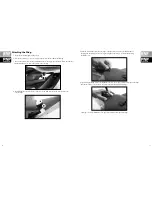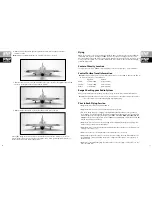
28
29
4. With the aileron stick pushed right, the right aileron should move up and the left aileron
should move down.
Note: If using a Spektrum transmitter, the ailerons will need to be reversed.
5. Move the rudder stick to check yaw control. When the stick is pushed to the right the rudder should
also move to the right (if viewed from behind the airplane).
6. With the rudder stick pushed to the left, the rudder should move to the left.
If at any time during the test the controls respond in the opposite direction, it may be necessary to
reverse/change the direction of operation of the flight controls. Follow your transmitter instructions to
change the direction of the various flight controls.
Always choose a wide-open space for flying your ParkZone Habu. It is ideal for you to fly at an AMA sanc-
tioned flying club. If you are not flying at an AMA approved site, always avoid flying near houses, trees,
wires and buildings. You should also be careful to avoid flying in areas where there are many people, such
as busy parks, schoolyards, or soccer fields. Always follow local ordinances. We recommend only flying
your Habu in light winds.
The CG location is 4 inches (102mm) from leading edge at the root of the wing +/- 1/4 inch (6.4mm).
Note: Measured at widest point of control surface. Dual rates are set for 100% on high rate and 70% for
low rate with all surfaces set for 100% ATV.
High Rate
Low Rate
Aileron:
3/4-inch (19mm)
1/2-inch (13mm)
Elevator:
5/8-inch (16mm)
1/2-inch (13mm)
Rudder:
1-inch (25mm)
3/4-inch (19mm)
After you have finished the final assembly, it is time to range check the radio system within the Habu.
Note: Before flying after all control surfaces have been centered it is advisable to re-bind the airplane so
the control surfaces are neutral when plugging in the flight battery.
• Always make sure your Habu is properly trimmed.
• Always make sure the receiver, ESC, and battery are properly secured.
• Turn on the transmitter prior to plugging in the flight battery. With the airplane on the ground and
motor running, you should walk away approximately 100 feet and still have full control of all functions
while following the specific range test feature of your DSM2 transmitter. If this is not the case, do
not fly . Call the Horizon Support Team at 1-877-504-0233, United Kingdom at +44 (0) 1279 641 097
or Germany at +49 4121 46199 66.
• Always make sure that all controls are functioning per the transmitter input that you are giving. This
includes ailerons, rudder, elevator and throttle.
• Always make sure you have fully charged the transmitter batteries or make sure your transmitter has
fresh dry cells before you fly.
• Always ensure the servo reversing switches on the transmitter are set correctly.
• Always verify the dual rates switch is set at where you plan on flying. We recommend LOW rates for
your initial flying. The Habu is VERY maneuverable on high rates and requires a lot of experience to
handle properly.
• Always remove the flight battery from the airplane when you are done flying, or when you are on the
way to the flying field.
Flying
Control Surface Travel Information
Center of Gravity Location
Range Checking your Radio System
Prior to Each Flying Session
Содержание Habu BNF
Страница 20: ...38 39...




















